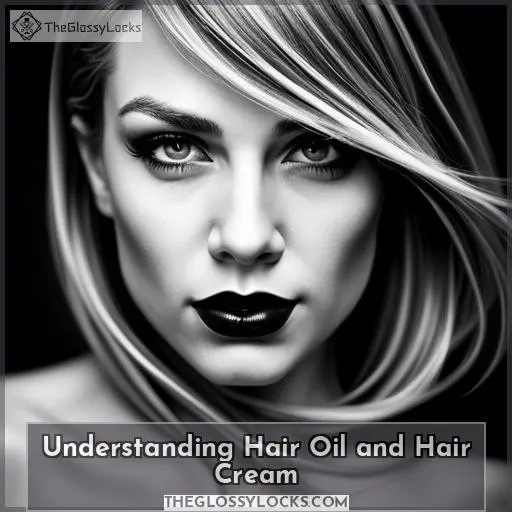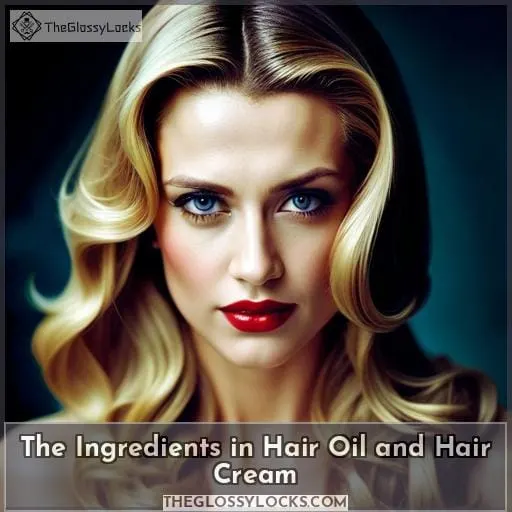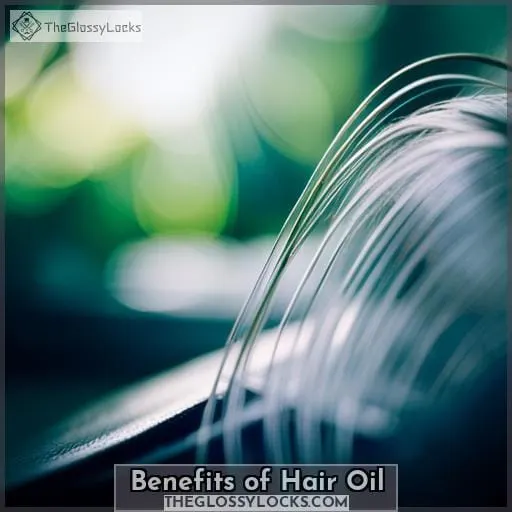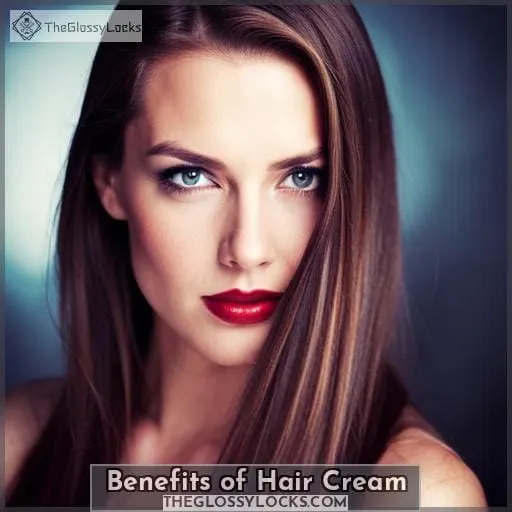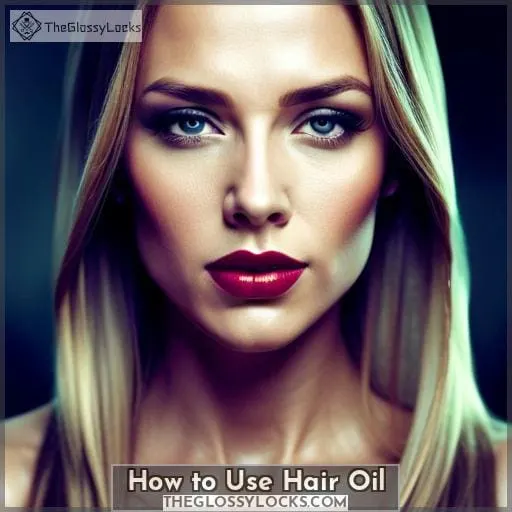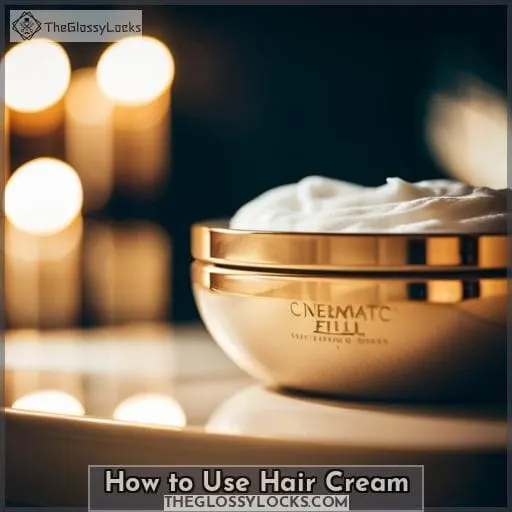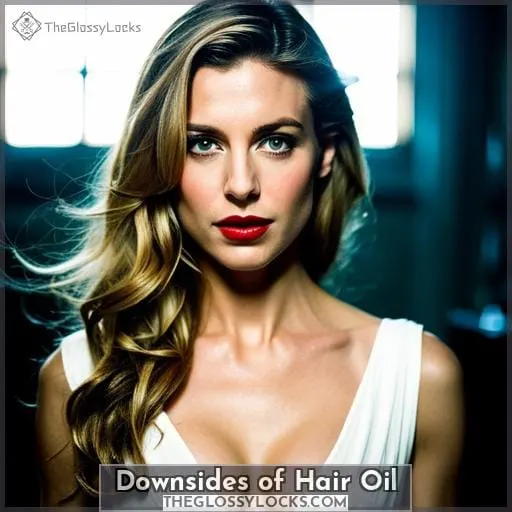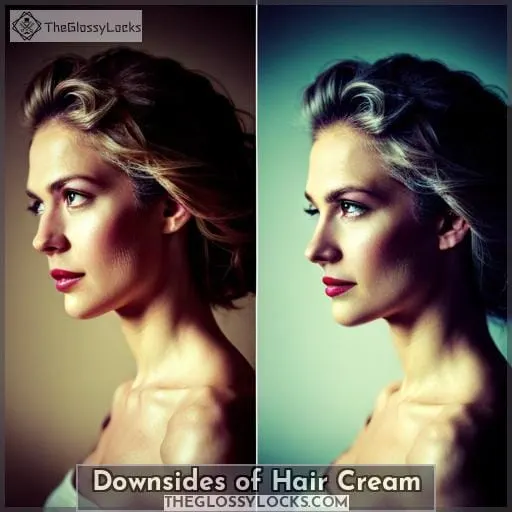This site is supported by our readers. We may earn a commission, at no cost to you, if you purchase through links.
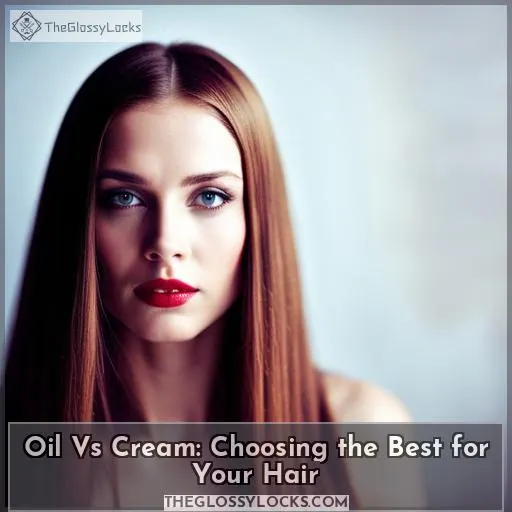 Navigating the world of hair products can be a daunting task, with countless bottles and jars lined up on store shelves. It’s like walking into an unfamiliar land without a map; you know you need to find something that works for your hair type, but it’s hard to figure out where to start.
Navigating the world of hair products can be a daunting task, with countless bottles and jars lined up on store shelves. It’s like walking into an unfamiliar land without a map; you know you need to find something that works for your hair type, but it’s hard to figure out where to start.
Enter oil vs cream: two powerful tools in the fight against dryness, damage, and frizziness. Whether your tresses are straight or curly – understanding how these two options work differently is key in choosing which one will give you the best results for your specific needs.
Oil offers deep nourishment while creams provide styling benefits – both have their pros and cons when it comes down to repairing versus styling each individual strand of hair!
Table Of Contents
Key Takeaways
- Hair oils offer deep nourishment, improved strength, shine, and detangling.
- Hair oils penetrate deeply and provide intense moisture while also protecting against heat damage.
- Potential downsides of hair oil include greasiness, scalp irritation, and dirt buildup.
- Hair creams provide styling hold, reduce frizz, aid in moisture retention and repair, and are suitable for all hair types.
Understanding Hair Oil and Hair Cream
Whether you’re looking for deep nourishment or surface protection, understanding the differences between hair oil and cream can help you find the right product to suit your needs. Hair oils are typically made with nutrient-rich ingredients such as almond, argan, jojoba, and coconut oil, which penetrate into the scalp, providing hydration and moisture.
Benefits include improved strength, shine, and detangling, while potential downsides may be greasiness or scalp irritation if not used correctly.
On the other hand, creams usually contain water-based ingredients like glycerin that coat hair strands, giving styling hold without weighing it down too much.
Knowing how to choose between them will ensure a tailored approach to finding what works best for your individual type, ensuring optimum health benefits each time they’re used.
The Ingredients in Hair Oil and Hair Cream
If you’re interested in learning about the ingredients found in hair oil and cream, look no further! Hair oils usually contain almond, argan, shea butter, jojoba, olive, or coconut oil, which provide hydration and nutrients.
On the other hand, creams possess glycerin, mineral oils, water, fatty alcohols, dimethicone, and lanolin to offer styling hold, frizz reduction, shine, moisture, and repair.
Hair Oil Ingredients
You’ll be amazed at the nourishing ingredients found in hair oil, from almond and argan oils to shea butter and jojoba. Hair oil is a great way to provide nutrients, shine, hydration, and affordability for your hair.
It penetrates deep into the strands, providing more intense moisture than creams or serums can offer. To use it effectively, apply it on dry hair with a circular massage motion. Then, cover it with a shower cap before washing it out thoroughly afterwards.
Be aware that if you’re not careful, there may be potential greasiness or scalp irritation involved. Additionally, dirt may build up over time due to its thickness compared to cream or serum products, which are lighter weight options for styling needs like frizz reduction and humidity protection.
All these benefits of using an oil product versus a cream make it worth considering when deciding which one works best for you!
Hair Cream Ingredients
Try a nourishing hair cream to keep your locks soft and hydrated with ingredients like glycerin, mineral oils, water, fatty alcohols, dimethicone, and lanolin. Hair creams can provide styling hold, reduce frizziness, and add shine and moisture.
To use the product effectively on damp hair, distribute it evenly throughout strands, then let it dry naturally or with heat tools. Its benefits include lightweight hold without weighing down tresses, as well as affordability compared to other products in the market for similar results.
However, be sure to read labels carefully if you have a sensitive scalp since some creams contain sulfates that may lead to irritation.
Cream is more suitable for those who require quick absorption moisturizing power rather than the deep nourishment of oil-based products, which are better suited for all types of scalps.
Benefits of Hair Oil
If you’re looking for improved moisture and hydration, enhanced strength and shine, as well as detangling and manageability in your hair product routine, then look no further than hair oil. Hair oils are packed with essential nutrients that help nourish your scalp while providing a natural sheen to give life back to tired-looking locks.
Improved Moisture and Hydration
Your mane will be loving life with the added moisture and hydration of hair oil. Hair oils penetrate deep into the scalp and strands, nourishing them from within. Serums, on the other hand, coat the surface to protect against heat styling damage.
Compared to creams that provide hold but can weigh down hair or cause scalp irritation due to sulfates, oils are a great choice for all types of hair.
With a simple application on dry locks followed by washing off with shampoo and conditioner later on, you’ll be seeing improved texture in no time! So why not give it a try?
Enhanced Strength and Shine
When you use an oil, you can expect to see enhanced strength and a noticeable boost in shine. Oils help protect the hair from damage caused by styling and provide nourishing ingredients that hydrate dry strands.
For best results, choose products tailored to your hair type and needs for maximum effect. Oil application will also depend on the texture of your hair. Thicker oils may work better with coarser textures, while lighter oils suit finer ones.
When selecting a product for strength vs shine, pay attention to key ingredients like mineral oil or shea butter. These offer more moisture protection than creams do when it comes to styling products. They also provide repair benefits such as split ends control or frizz reduction when using serums specifically formulated for this purpose.
With the right approach and product selection, you’ll be able to keep your locks looking healthy!
Detangling and Manageability
By using an oil like ALODIA Healthy Hair Oil Rosemary Avocado, you can experience improved detangling and manageability with just a few drops – as the saying goes, a little goes a long way! Oils penetrate deep into hair follicles to nourish from within, while creams provide lightweight styling benefits.
Serums offer humidity protection while adding shine. All of these products work together for maximum frizz control and moisturizing treatment that leaves your strands soft and manageable.
Benefits of Hair Cream
Hair cream is an essential product for styling and holding your hair, reducing frizz, and providing moisture. It also helps to add shine to dry or damaged hair while repairing split ends. Formulated with glycerin, mineral oils, water, fatty alcohols, and dimethicone among other ingredients, it can be used on damp hair before drying for best results.
Styling and Hold
You can rely on hair cream to provide hold and styling control, while locking in moisture for a smooth finish. Hair creams are great for mid-length to long styles, helping you achieve frizz-free results with minimal product buildup.
Whether your hair is curly or straight, damaged or healthy, you’ll find the perfect styling product that gives your locks an added boost of shine and protection from heat damage without weighing them down.
Frizz Reduction and Shine
With its nourishing ingredients like glycerin and mineral oils, hair cream can help you achieve the smooth, frizz-free locks of your dreams while adding a glossy sheen. Creams also provide hold for styling with heat tools and aid in preventing split ends.
Hair creams are great for all hair types because they don’t weigh down fine strands or leave an oily residue behind on thicker tresses.
Moisture and Repair
Experience the power of moisture and repair with a cream specially designed for your hair type. For any hair texture, length, or needs, there is an apt product: from nourishing almond oil to glycerin-rich creams; mineral oils to ensure hold and frizz reduction; fatty alcohols for shine; lanolin for hydration.
Investing in quality products can help you navigate through moisturizing techniques, repair strategies, and other essential hair care practices tailored specifically to you.
How to Use Hair Oil
For optimal results, apply hair oil to dry hair and gently massage it. Then, cover your head with a shower cap to help the oil penetrate better before washing and conditioning as usual.
Application on Dry Hair
Feel the nourishing effects of hair oil as you massage it into your dry strands. Its ingredients, like almond, argan, and jojoba, provide improved moisture retention and hydration to promote strength and shine.
For best results, use a shower cap after application before washing with conditioner for added benefits like nutrients and affordability. Oil has lightweight properties compared to cream products, making it suitable for all types of hair.
However, be cautious when using serums on curly tresses due to potential buildup from silicones or silicone-like substances used in their formulas.
Hair rituals are key. Use an oil once weekly for deep nourishment, then layer with serum daily for heat protection.
Massage and Use of Shower Cap
Gently massage your scalp with the oil, and then cover it up with a shower cap – like a warm hug for your locks. Massaging benefits include improved blood circulation, reduced stress hormones, and stimulation of natural oil production.
Shower caps are also essential to keep dirt out while you let the oil work its magic! Haircare routines, including hot oil treatments, can be great investments in hair health as they provide deep nourishment without greasiness or overburdening scalps.
Choosing between oil and cream for hair depends on individual needs, but both should form an integral part of haircare routines to achieve desired results!
Wash and Condition
After you’ve allowed the oil or cream to settle into your hair, lather up with shampoo and a conditioner for your beard for a nourishing wash that’ll leave your hair feeling silky-smooth.
Hair maintenance is essential for scalp health. Use a shower cap to help keep products from running down during cleansing. Choose a suitable type of cleanser based on your skin type, especially when using oil vs cream for hair care.
To get the most out of these products, make sure to apply them properly according to the instructions. This includes using the right amount of product and using it as often as recommended. Also, allow each product enough time to penetrate before thoroughly washing it off with water.
Start taking care of your hair today!
How to Use Hair Cream
Applying hair cream can be a great way to style and nourish your hair. When used on damp hair, you should distribute the cream evenly throughout the strands before styling as desired.
Application on Damp Hair
Apply your chosen product to damp hair, distributing it evenly for optimal results. When selecting a hair cream, consider its ingredients and their effects on your specific hair type. Damp application is especially beneficial because the products can penetrate deeper into the strands for long-lasting hydration and softness, without causing greasiness or scalp irritation.
For extra shine and softness, use a styling tool after applying to achieve an even glossier finish. Just be careful not to overheat! Make sure the product you choose helps protect against heat styling damage while providing gentle nourishment for silky smooth locks all day long.
Hair creams are also great moisturizers for dry skin. They lock in moisture without feeling heavy or weighing down your hair.
Distribution and Styling
Once you’ve applied your cream, make sure to spread it evenly through your hair and style as desired.
Selecting the right product for optimal results is key. Use a lightweight cream or lotion for combination/oily skin and an ointment or balm with higher oil content if dryness is present.
Consider heat protection when styling, especially important when using hot tools like curling irons on curly hair!
Remember that oils penetrate the hair shaft while creams provide surface protection – choose accordingly!
Keep in mind that product selection directly impacts results. Opt for quality products designed specifically to enhance hydration, moisture retention, shine, and strength of all types of locks – from fine to coarse – so you can enjoy healthy-looking tresses long-term.
Drying Process
Gently pat your hair with a towel to remove excess moisture, then allow it to air-dry until it’s damp before styling with cream for a hydrated and soft finish.
Depending on your hair texture, you can opt for different drying techniques. You can choose from diffusing, plopping, scrunching, or wrapping.
For extra heat protection and shine, apply a serum while the hair is still damp prior to using the cream.
Apply product section by section starting at the ends of each strand and work up towards roots for even distribution without weighing down your style.
To complete your look, use oil instead of cream depending on desired results and skin type.
Serums should be used sparingly due to their high silicone content, which may cause buildup over time, especially when paired with gel products like aloe vera gel. However, aloe vera gel is specifically designed for sunburn relief applications only.
Downsides of Hair Oil
Using hair oil can provide numerous benefits for your hair, from improved moisture to increased shine. However, there are some downsides to using it that you should be aware of before making the decision to use an oil-based product – potential greasiness, scalp irritation, and dirt buildup may occur.
Potential Greasiness
When using hair oil, you may experience a greasy feeling on your scalp and hair. Managing this greasiness is important for healthy-looking locks.
To prevent oiliness, use small amounts of product and thoroughly massage it into the scalp in circular motions before washing out with shampoo. For extra grease control, consider adding some dry shampoo or blotting paper to absorb excess oils in between washes.
Grease-free solutions can be achieved when styling by switching from an oil-based formula to a cream-based one that offers more hold without weighing down your tresses too much and costing less than its oily counterpart!
Follow these tips for grease management; you’ll be rewarded with healthier-looking hair without compromising on style!
Scalp Irritation
Be aware that using hair oil can sometimes cause scalp irritation. Oily skin, excess sebum production, and the wrong formulation of ingredients all contribute to scalp discomfort. To prevent this, choose products tailored to your individual needs and seek dermatologist guidance when necessary.
Opt for ointments over creams if you’re dealing with severely dry or irritated scalps.
Additionally, practice proper scalp care habits such as exfoliating regularly and avoiding harsh chemicals like sulfates in shampoo formulas.
Be mindful of any health concerns related to your scalp before trying new products or treatments.
Dirt Buildup
Regular use of hair oil can lead to dirt buildup in your strands, leaving them weighed down and dull. Preventing this requires a regular cleansing routine that also manages excess oil production from the scalp.
To maintain healthy locks, incorporate products like shampoos or cleansers tailored for oily scalps into your regimen to help lift away product residue and build up without stripping away necessary moisture.
Alternating between light oils like jojoba or argan with heavier ones such as olive can help balance out scalp health while avoiding any unwanted accumulation on the hair shafts.
Skin moisturizers such as lotion or cream may be used instead of an additional conditioner if desired since they don’t leave behind an oily film when rinsed off properly.
Downsides of Hair Cream
When choosing a hair cream, it is important to be aware of the potential downsides. Hair creams can cause scalp irritation due to sulfates and weigh down your hair, so make sure you choose one that suits your needs.
Scalp Irritation (Sulfates)
You may be surprised to learn that scalp irritation, caused by sulfates in hair creams, could be the hidden culprit for your dry and itchy head. Hair care routines are important when it comes to keeping our locks healthy, and choosing the right products is key.
Many hair product ingredients contain harsh chemicals or silicones, which can cause damage over time. So, look out for sulfate-free shampoos if you have sensitive skin. Chemical treatments such as perms or dyes can also lead to scalp irritation, on top of using the wrong products for your curly tresses.
Lotions with alcohol are great candidates for oily, acne-prone skin, but not ideal if you’re looking to keep moisture locked into your strands without compromising their health.
With careful consideration of ingredient labels and routine maintenance of our scalps, we can ensure healthier-looking locks minus any unwanted effects like itching or flaking due to scalp irritations caused by wrong choices in hair care products.
Weighing Down Hair
Contrary to lotions, creams can weigh down hair due to their higher oil content. This is especially true for those with naturally fine or thin hair that may not respond well to the additional moisture and heavy product layering.
To prevent this from happening, opting for a lightweight cream such as Mizani Press Agent is key. It provides heat protection and styling control without weighing down your texture.
Additionally, it’s important to consider your individual needs when selecting products.
Utilizing proper blow drying techniques, coupled with an appropriate shield spray, can also assist in keeping unwanted weight at bay while still allowing flexibility during styling routines.
Choosing the Right Product for Your Hair
Are you considering whether to use hair oil or cream for your locks? Choosing the right product depends on several factors, such as your hair type and personal preferences. It’s important to consider what goals you have in mind when selecting a product; do you want volume, hydration, shine, or all three? With so many options available today, it can be difficult to decide which one best suits your needs.
Hair Type Considerations
When deciding between an oil and a cream for your hair, consider the type of hair you have. Oils are suitable for all types, while serums may require more caution with curly hair due to potential buildup.
For dry or damaged locks, creams provide extra moisture and protection from heat styling.
For oily strands, try lotions that contain more water than oil to keep it lightweight without weighing down your style.
- Oils suit all hair types; serums need caution with curly/frizzy textures.
- Creams provide extra moisture & protection from heat styling.
- Lotions are ideal for combination/oily skin – contains more water than oil.
- Check the ingredient list before purchasing products.
Hair Goals and Needs
Identify what your hair needs and goals are to choose the right product for you. Consider how often you want to use a product, whether it’s daily or weekly. Think about if there’s an area of concern, such as scalp health, dryness, frizziness, or breakage, that could be addressed with specific ingredients like shea butter and argan oil in oils.
For styling purposes, gels containing alcohol may work better than creams, which can weigh down finer textures, while serums provide heat protection and shine without greasiness.
Personal Preference
Once you’ve determined your hair goals and needs, it’s time to consider personal preference when selecting an oil or cream for your hair.
- Hair texture – is it thick, thin, or curly?
- Styling choices – do you prefer braids or updos?
- Product selection – what type of ingredients work best with your strands?
- Hair care routine – how often will the product be used?
- Desired results – shine boost or repair damage caused by styling tools? Consider all these characteristics before deciding on a product based on individual preferences and lifestyle habits!
Conclusion
In short, when it comes to choosing the right product for your hair, it’s important to consider the type of hair you have, your hair goals and needs, as well as your personal preference.
Hair oil and cream have different ingredients and offer different benefits. Hair oil is great for providing moisture, hydration, strength, shine, and detangling. On the other hand, hair cream is ideal for styling, hold, frizz reduction, shine, and repair.
However, both can have downsides, such as potential greasiness, scalp irritation, and dirt buildup.
Ultimately, the key to finding the perfect combination of products for your hair is to experiment and see what works best for you.

